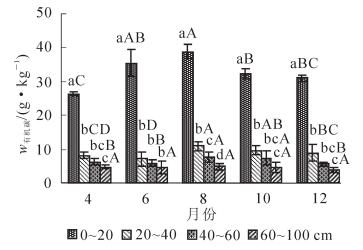-
对土壤有机碳进行分组及测定是明确土壤有机碳动态对陆地生态系统碳循环影响的基础。对土壤有机碳成分划分的研究较早,其中较为经典的是Century模型。根据Century模型碳循环,土壤有机碳可划分为活性碳、缓效碳和惰性碳[1]等3种组分类型。一些学者以此为依据,从有机碳组分变化[2-5]、温度和有机碳质量分数对矿化强度的影响[6-8]以及不同模型对矿化过程的拟合效果[9]等方面开展了相关研究。现有的研究多是针对土壤活性碳质量分数开展的,忽略了对缓效碳及活性碳—缓效碳转化的分析,不利于对土壤有机碳组分特征的全面认识,同时对组分含量动态变化研究的缺乏,也不利于对有机碳转化特征的深入认识。丝栗栲Castanopsis fargesii林是中国亚热带地区天然林的主要建群种之一,是影响地区森林生态系统和碳循环特征的重要因素。迄今,虽有学者针对丝栗栲林的生态特征,如群落结构、光合特性和群落生物量等,开展了相关研究[10-13],但有关其林下土壤有机碳特征的针对性研究很少[14]。为此,本研究以江西大岗山天然丝栗栲林土壤为研究对象,利用室内矿化培养,探讨了土壤有机碳、活性碳和缓效碳质量分数的时空年变化特征,以期为该区域丝栗栲林生态系统固碳现状评价、碳汇林业与持续管理策略的制定提供理论依据。
-
研究区位于江西省分宜县大岗山国家级森林生态站,地处27°30′~27°50′N,114°30′~114°40′E。属亚热带季风气候,年平均气温为17.7~19.3 ℃,年平均降水量为1 076.0~1 472.0 mm,降水主要集中在4-6月。成土母质为残积形母质。土壤属红黄壤。
-
在研究区设置3块20 m × 20 m的样地,样地优势树种为丝栗栲,平均海拔为275 m。调查数据显示,丝栗栲林平均林龄为45 a,平均树高为23 m,平均胸径为25 cm,林分郁闭度为80%。于2012年4,6,8,10和12月按S型取样法分别采集0~20,20~40,40~60和60~100 cm的土壤混合样品。采集的新鲜样品部分根据《森林土壤分析方法》[15]风干处理,过2 mm和0.149 mm筛后备用,部分于-4 ℃保存,用于土壤微生物碳测定。
另挖掘1个剖面,在0~20,20~40,40~60和60~100 cm土层深度布设自动测温仪(U22-001)后回填,连续测定各层土壤温度,测定时间为1 a。
-
土壤有机碳质量分数(SOC)采用重铬酸钾容量法-外加热法[16]测定。
土壤活性碳(Co)质量分数和缓效碳(Cs)质量分数测定方法:室内28 ℃恒温条件下矿化培养96 d,其间利用碱液吸收法[17]分别测定第1,4,6,8,12,14,24,34,44,54,65,75,86和96天的二氧化碳释放量。利用Boyle和Paul双指数方程[18]拟合出不同层次土壤有机碳矿化时间(t)与t时间二氧化碳累积释放量的拟合方程,从而获取土壤活性碳和缓效碳质量分数[3-4, 14]。Boyle和Paul双指数方程如下:$ {C_{{\rm{min}}}}{\rm{ = }}{w_{{\rm{Co}}}}\left( {1 - {{\rm{e}}^{ - {k_{\rm{o}}}t}}} \right) + {w_{{\rm{Cs}}}}\left( {1 - {{\rm{e}}^{ - {k_{\rm{s}}}t}}} \right)$。其中:Cmin为经过t时间后土壤累积释放量(g·kg-1);wCo为土壤活性有机碳质量分数(g·kg-1);ko为活性有机碳库周转速率(d-1);wCs为土壤缓效性有机碳质量分数(g·kg-1);ks为缓效性有机碳库周转速率(d-1)。
土壤微生物磷脂脂肪酸(PLFA)质量分数采用生物标记法[19]测定。
各层土壤温度利用自动测温仪(U22-001)进行测定。
-
土壤有机碳矿化过程的拟合采用Origin 8.6软件进行。数据间的方差分析、多重比较采用SPSS 17.0进行。
-
各时期土壤有机碳质量分数都表现出随土壤深度的增加而降低的剖面变化特征,0~20 cm土壤有机碳表聚现象显著(P<0.05)。8月0~100 cm深度范围内,各层土壤有机碳质量分数差异显著(P<0.05),但在其他时期,0~20 cm以下各层土壤有机碳质量分数则表现出逐渐降低的变化特点,层间差异不显著(P>0.05)。不同时期各深度土壤有机碳质量分数都呈现出先升高后降低的变化趋势,8月为全年最高值。60~100 cm土壤有机碳质量分数虽也表现出相同变化,但全年各时期差异不显著(图 1)。
-
各个时期土壤活性碳质量分数表现出与土壤有机碳总量相似的剖面变化特征,即,0~20 cm土壤活性碳质量分数最高,表聚现象显著(P<0.05)。土壤活性碳质量分数与土壤有机碳总量的不同处出现在8月,该时期0~20 cm其下各层土壤活性碳质量分数并没有像土壤有机碳总量一样出现显著的层间差异,表现为逐渐降低的层间变化特点(图 2)。
同层土壤活性碳质量分数全年的变化趋势与有机碳总量相似,也呈现出先增加后降低的趋势。具体表现为:8月>10月>6月>12月>4月。但0~100 cm深度范围内,同层土壤活性碳质量分数差异相邻月份间未达到显著水平,各层活性碳质量分数表现为缓慢增加和减少的趋势(图 2)。
4-6月,0~20 cm土层中土壤活性碳质量分数变速最为强烈,平均变化速度为1.30 g·kg-1·月-1,绝对值为其他各月的1~2倍左右。比较4-8月与8-12月的平均值可以看出,0~20 cm土层间平均值差异较大,分别为1.05 g·kg-1·月-1和-0.65 g·kg-1·月-1,全年活性碳质量分数净增长速率为0.40 g·kg-1·月-1,但20~100 cm深度范围内,仅为0.05 g·kg-1·月-1,表明土壤活性碳质量分数的增加主要集中在0~20 cm表层,且4-6月贡献最大,20~100 cm土壤对活性碳质量分数增加的影响相对较小(表 1)。
表 1 土壤活性碳质量分数的月平均变化速度
Table 1. Monthly average change rate of soil active carbon mass fraction
月份 土壤活性碳质量分数变化/(g·kg-1·月-1) 0~20 20~40 40~60 0~100 cm 4-6 1.30 0.60 0.20 0.10 6-8 0.80 0.90 0.40 0.10 平均值 1.05 0.75 0.30 0.10 8-10 -0.60 -0.70 -0.10 0 10-12 -0.70 -0.70 -0.40 -0.10 平均值 -0.65 -0.70 -0.25 -0.05 说明:变化速度为相邻两月土壤活性碳平均质量分数之差/2 -
土壤缓效碳质量分数表现出与土壤有机碳总量相似的剖面垂直变化和相同的全年时间变化趋势。8月土壤缓效碳质量分数不仅表现出明显的表聚特点,而且0~20 cm以下各层还呈现出明显的层间变化特征。此外,从4月到6月,缓效碳质量分数出现显著增加(P<0.05),从4.97 g·kg-1增至6.69 g·kg-1,平均变化速度为1.10 g·kg-1·月-1,为全年最高,其后的6-8月,缓效碳虽仍保持增加的趋势,但变化不显著。进入10月后,月平均变化速度表现出较高的负增长,达-0.93 g·kg-1·月-1,土壤缓效碳质量分数从8月的7.71 g·kg-1降至5.86 g·kg-1,出现显著降低(P<0.05)(表 2,图 3)。
表 2 土壤缓效碳质量分数月平均变化速度
Table 2. Average monthly change rate of soil slow-release carbon mass fraction
月份 土壤活性碳质量分数变化/(g·kg-1·月-1) 0~20 20~40 40~60 0~100 cm 4-6 1.10 0.27 0.02 0 6-8 0.51 0.16 0.04 0 平均值 0.81 0.22 0.03 0 8-10 -0.93 -0.12 0.14 0.16 10-12 -0.56 -0.06 -0.10 -0.16 平均值 -0.75 -0.10 0.02 0 说明:变化速度为相邻两月土壤活性碳平均质量分数之差/2 -
受到气候变化和群落组成树种的生物学特性的影响,亚热带常绿阔叶林在每年4-5月降雨初期出现凋落高峰期[19, 21-23]。赵其国等[22]研究发现:地表凋落物在最初的90 d分解最快,失重率为13.6%~20.8%,90~180 d次之,失重率为19.6%~41.8%,此后变化较小。AERTS等[24]和郭剑芬等[25]认为:在同一气候带内凋落物质量是影响其分解过程最为重要的因素,控制着凋落物分解过程。受凋落物理化性质的影响,凋落物初期分解速率较快,之后随着难分解物质的增加,凋落物分解受到抑制,分解速率明显减慢[24, 26-27]。4-5月凋落物峰值出现以及土壤温度升高(图 4)和微生物活性增强(图 5,表 3),凋落物进入快速分解阶段,不仅造成土壤矿化过程增强,增加了土壤中速效养分含量,保证林木夏季生长,同时强化了土壤腐殖化过程,0~20 cm土壤有机碳总量在6月出现显著增加(图 1,表 3)。对组分质量分数变化进一步分析表明:该时期0~20 cm土壤活性碳质量分数虽然以全年最大值(1.3 g·kg-1·月-1)的平均速度大幅增加,但同时土壤缓效碳质量分数也以全年最大值(1.1 g·kg-1·月-1)的平均速度增加,反映出该时期土壤活性碳向缓效碳的转化过程强烈。这种强转化过程导致土壤活性碳质量分数增加不显著,而土壤缓效碳质量分数却显著增加的变化特点(图 2和图 3,表 1,表 2和表 3),因此,该时期土壤有机碳总量的显著提高主要归于缓效碳质量分数的增加。经过4-5月的前期快速分解,进入6-8月后,由于凋落物数量减少和难分解物质比例的增加,凋落物分解速率减缓,0~20 cm土壤活性碳和缓效碳质量分数虽继续保持增加的趋势且在8月达到全年最大值,但该时期2个组分的质量分数以及土壤有机碳总量都没有显著变化。20~60 cm土壤表现不同,虽然土壤活性碳和缓效碳质量分数也表现为缓慢增加的特点,但两者共同作用导致该层土壤有机碳总量出现显著增加(图 1,图 2和图 3,表 3)。由于林木夏季生长的吸收消耗,土壤养分含量减少[28]。为了满足秋季生长的需要,8-10月,土壤矿化作用增强,土壤缓效碳向活性碳的转化过程强烈,缓效碳质量分数出现显著降低,导致0~20 cm土壤有机碳总量在10月出现显著变化(图 1和图 3,表 3)。
表 3 有机碳、活性碳和缓效碳与温度和微生物的相关性
Table 3. Correlation between soil organic carbon, active carbon, slow-rease carbon and temperature and microbial
成分 有机碳 活性碳 缓效碳 微生物 温度 有机碳 1 活性碳 0.970** 1 缓效碳 0.991** 0.964** 1 微生物 0.776** 0.881** 0.782** 1 温度 0.108 0.241 0.142 0.509* 1 说明:*表示在0.05水平(双侧)上显著相关,**表示在0.01水平(双侧)上显著相关 各层土壤活性碳质量分数年变化趋势与土壤有机碳总量和缓效碳质量分数变化趋势相同,但相邻的生长期之间都没有出现质量分数的显著增加或减少。这种变化特点应和活性碳—缓效碳间的转化强度及气候影响有关。以0~20 cm土壤为例,由于温度、微生物活动和丰富的凋落物等因素的影响,4-6月间土壤活性碳质量分数虽然以全年最大值的月平均速度大幅增加,但同时存在的强烈的土壤活性碳向缓效碳转化过程减弱了土壤活性碳的增加幅度,使该时期土壤活性碳质量分数没有表现出显著的增加。此外,该时期为研究地区的梅雨季节,2012年4-6月的降水量分别为210,220和250 mm,由于土壤活性碳的易溶性,会有相当数量的土壤活性碳受到淋洗,影响其质量分数的增加。进入8-10月后,土壤矿化作用加强,随着土壤活性碳分解,质量分数降低,土壤缓效碳质量分数也以-0.93 g·kg-1·月-1的平均速度迅速减少,出现显著降低。由于该时期土壤缓效碳的不断转化补充,土壤活性碳质量分数没有因为矿化作用的加强出现显著降低(图 2和图 3,表 1、表 2和表 3)。
-
不同生长时期土壤有机碳总量及土壤活性碳和缓效碳质量分数都表现出随深度增加而降低的剖面垂直特征,其中,8月层间变化最为强烈,而其他时期只有0~20 cm出现明显富集。此外,三者还表现出4-8月增加,8月达到最大值,其后逐月降低的时间变化特征。
土壤缓效碳质量分数是影响4-6月和6-8月两阶段0~20 cm土壤有机碳总量显著变化的主要原因,而6-8月20~60 cm土壤有机碳总量的显著增加则是活性碳和缓效碳共同作用的结果。
由于土壤活性碳—缓效碳间的转化强度及气候等因素的影响,相邻生长期间土壤活性碳质量分数没有明显变化。
Annual spatial and temporal variations of soil organic carbon and its components in Castanopsis fargesii forest
-
摘要: 以江西大岗山天然丝栗栲Castanopsis fargesii林下土壤为研究对象,分析土壤有机碳、活性碳和缓效碳质量分数的时空变化特征,为该区域丝栗栲林土壤生态系统固碳现状评价与林业持续管理策略的制定提供理论依据。通过重铬酸钾容量法及室内28 ℃恒温条件下矿化培养和双指数方程拟合方法分别获取不同时期土壤有机碳总量以及土壤活性碳和缓效碳质量分数。土壤有机碳、活性碳和缓效碳质量分数的时空变化采用单因素方差分析方法,数据间的多重比较采用最小显著差(LDS)法。结果表明:土壤有机碳总量以及土壤缓效碳和活性碳质量分数具有相同的剖面特点,0~20 cm表层富集现象明显;和其他时期相比,8月层间质量分数变化最强烈(P < 0.05)。0~100 cm深度范围内,土壤有机碳总量以及活性碳和缓效碳质量分数都表现出4-6月增加、8月最大,其后降低的时间变化特征。4-6月和8-10月0~20 cm土壤缓效碳—活性碳转化强烈,土壤缓效碳质量分数变化显著(P < 0.05),成为影响该阶段土壤有机碳总量显著变化的重要因素。土壤活性碳质量分数没有明显的时间差异变化;4-6月是0~20 cm土壤活性碳质量分数增速最快的阶段,增加速率达1.30 g·kg-1·月-1,但由于受到活性碳—缓效碳强转化和梅雨淋洗的影响,土壤活性碳质量分数没有出现明显增加。土壤有机碳总量和缓效碳质量分数的时空变化特征更为一致。Abstract: To provide a theoretical basis for evaluation of the carbon sequestration status of a soil ecosystem in a Castanopsis fargesii forest and for development of a sustainable forestry management strategy in the study region, soil from C. fargesii in Dagangshan, Jiangxi Province was taken as the research object. Using the method of potassium dichromate volumetric and mineralization with a constant indoor temperature of 28℃ and then fitted with a double exponential equation to get the contents of soil organic carbon, soil active carbon and slow-release carbon respectively. Characteristics of spatial and temporal variation for soil organic carbon (SOC), active carbon, and slow-release carbon content were analyzed using one-way ANOVA and multiple comparisons between data using the LSD method. Results showed that the soil organic carbon, slow-release carbon and active carbon contents had the same profile characteristics and accumulated in 0-20 cm surface soil. Compared to April, June, October and December, the interlayer content in August changed significantly (P < 0.05). For a depth of 0-100 cm, the total SOC, active carbon and slow-release carbon content had the same temporal variation characteristics increasing from April to June, reaching a maximum in August, and then decreasing. Conversion of soil slow-release carbon and active carbon from April to June and August to October was strong; soil slow-release carbon content was changed significantly (P < 0.05) and further lead SOC changed significantly in this stage. There was no significant difference in soil active carbon content between the different time. From April to June, the soil active carbon content for 0-20 cm was the fastest growing stage with a rate of increase of 1.30 g·kg-1·month-1, but there was no significant increase in soil active carbon content because of the conversion of active carbon into slow-release carbon and the plum rain season. In general, temporal and spatial changes of total SOC and slow carbon content were more consistent.
-
表 1 土壤活性碳质量分数的月平均变化速度
Table 1. Monthly average change rate of soil active carbon mass fraction
月份 土壤活性碳质量分数变化/(g·kg-1·月-1) 0~20 20~40 40~60 0~100 cm 4-6 1.30 0.60 0.20 0.10 6-8 0.80 0.90 0.40 0.10 平均值 1.05 0.75 0.30 0.10 8-10 -0.60 -0.70 -0.10 0 10-12 -0.70 -0.70 -0.40 -0.10 平均值 -0.65 -0.70 -0.25 -0.05 说明:变化速度为相邻两月土壤活性碳平均质量分数之差/2 表 2 土壤缓效碳质量分数月平均变化速度
Table 2. Average monthly change rate of soil slow-release carbon mass fraction
月份 土壤活性碳质量分数变化/(g·kg-1·月-1) 0~20 20~40 40~60 0~100 cm 4-6 1.10 0.27 0.02 0 6-8 0.51 0.16 0.04 0 平均值 0.81 0.22 0.03 0 8-10 -0.93 -0.12 0.14 0.16 10-12 -0.56 -0.06 -0.10 -0.16 平均值 -0.75 -0.10 0.02 0 说明:变化速度为相邻两月土壤活性碳平均质量分数之差/2 表 3 有机碳、活性碳和缓效碳与温度和微生物的相关性
Table 3. Correlation between soil organic carbon, active carbon, slow-rease carbon and temperature and microbial
成分 有机碳 活性碳 缓效碳 微生物 温度 有机碳 1 活性碳 0.970** 1 缓效碳 0.991** 0.964** 1 微生物 0.776** 0.881** 0.782** 1 温度 0.108 0.241 0.142 0.509* 1 说明:*表示在0.05水平(双侧)上显著相关,**表示在0.01水平(双侧)上显著相关 -
[1] PARTON W J, SCHIMEL D S, COLE C V, et al. Analysis of factors controlling soil organic matter levels in Great Plains grasslands[J]. Soil Sci Soc Am J, 1987, 51(1):1173-1179. [2] JONES C A. Estimation of an active fraction of soil nitrogen[J]. Commun Soil Sci Plant Anal, 1984, 15(1):23-32. [3] 杨添, 戴伟, 安晓娟, 等.天然林土壤有机碳及矿化特征研究[J].环境科学, 2014, 35(3):1105-1110. YANG Tian, DAI Wei, AN Xiaojuan, et al. Organic carbon and carbon mineralization characteristics in nature forestry soil[J]. Environ Sci, 2014, 35(3):1105-1110. [4] 刘浩宇, 巩晟萱, 王兵, 等.阿尔泰山冷杉林下土壤有机碳矿化特征[J].水土保持通报, 2016, 36(1):327-331. LIU Haoyu, GONG Shengxuan, WANG Bing, et al. Mineralization characteristics of soil organic carbon under Abies nephrolepis forest in Altai Mountains[J]. Bull Soil Water Conserv, 2016, 36(1):327-331. [5] 麻泽宇, 王丹, 戴伟, 等.阿尔泰山不同海拔梯度天然冷杉林土壤特征及肥力综合评价[J].水土保持研究, 2016, 23(5):134-140. MA Zeyu, WANG Dan, DAI Wei, et al. Soil characteristics and fertility evaluation of Abies sibirica forest at different altitude gradient in Altai Mountain[J]. Res Soil Water Conserv, 2016, 23(5):134-140. [6] GIARDINA C P, RYAN M G. Evidence that decomposition rates of organic carbon in mineral soil do not vary with temperature[J]. Nature, 2000, 404(6780):858-861. [7] FANG Chu, MONCRIEFF J B. The dependence of soil CO2 efflux on temperature[J]. Soil Biol Biochem, 2001, 33(2):155-165. [8] HOPKINS D W, SPARROW A D, ELBERLING B, et al. Carbon, nitrogen and temperature controls on microbial activity in soils from an Antarctic dry valley[J]. Soil Biol Biochem, 2006, 38(10):3130-3140. [9] PANG Huan, ZHANG Rui, DAI Wei, et al. Application of two exponential equation in the study of soil organic carbon mineralization in natural forests[J]. Adv J Food Sci Technol, 2014, 6(10):1117-1123. [10] 宋萍, 洪伟, 吴承祯, 等.中亚热带丝栗栲次生林群落高度级结构分析[J].应用与环境生物学报, 2003, 9(5):460-464. SONG Ping, HONG Wei, WU Chengzhen, et al. Highness class structure of Castanopsis fargesii secondary forest in the middle subtropic[J]. Chin J Appl Environ Biol, 2003, 9(5):460-464. [11] 赵广东, 王兵, 李少宁, 等.江西大岗山常绿阔叶林优势种丝栗栲和苦槠栲不同叶龄叶片光合特性研究[J].江西农业大学学报, 2005, 27(2):161-165. ZHAO Guangdong, WANG Bing, LI Shaoning, et al. Photosynthetic characteristics of dominant species Castanopsis fargesii and Castanopsis sclerophylla in different leaf ages in Dagangshan Mountain, Jiangxi Province[J]. Acta Agric Univ Jiangxi, 2005, 27(2):161-165. [12] 钱莲文, 吴承祯, 洪伟, 等.中亚热带丝栗栲群落物种-个体关系的研究[J].中国生态农业学报, 2004, 12(4):170-173. QIAN Lianwen, WU Chengzhen, HONG Wei, et al. Species-individuals relationships of Castanopsis fargesii community in the middle subtropics[J]. Chin J Eco-Agric, 2004, 12(4):170-173. [13] 林捷, 叶功富, 何建源, 等.武夷山丝栗栲天然林群落的物种多样性研究[J].江西农业大学学报, 2005, 27(3):340-344. LIN Jie, YE Gongfu, HE Jianyuan, et al. A study on species diversity in Castanopsis fargesii natural forest community in Wuyishan Mountains[J]. Acta Agric Univ Jiangxi, 2005, 27(3):340-344. [14] 巩晟萱, 王丹, 戴伟, 等.不同生长时期丝栗栲林下土壤有机碳含量及矿化特征[J].水土保持通报, 2015, 35(5):59-63. GONG Shengxuan, WANG Dan, DAI Wei, et al. Content and mineralization characteristics of soil organic carbon under Castanopsis fargesii forests in different growth periods[J]. Bull Soil Water Conserv, 2015, 35(5):59-63. [15] 国家林业局. LY/T 1210-1999森林土壤分析方法[S]. 北京: 中国标准出版社, 1999. [16] 鲍士旦.土壤农化分析[M]. 3版.北京:中国农业出版社, 2000. [17] ZOU X M, RUAN H H, FU Y, et al. Estimating soil labile organic carbon and potential turnover rates using a sequential fumigation-incubation procedure[J]. Soil Biol Biochem, 2005, 37(10):1923-1928. [18] BOYLE M, PAUL E A. Carbon and nitrogen mineralization kinetics in soil previously amended with sewage sludge[J]. Soil Sci Soci Am J, 1989, 53(1):99-103. [19] KOURTEV P S, EHRENFELD J G, HÄGGBLOM M. Exotic plant species alter the microbial community structure and function in the soil[J]. Ecology, 2008, 83(11):3152-3166. [20] 李明佳, 王铸豪. 鼎湖山常见植物的物候[G]//中国科学院鼎湖山森林生态系统定位研究站. 热带亚热带森林生态系统研究: 第2集. 广州: 科学普及出版社广州分社, 1984: 1-11. [21] 官丽莉, 周国逸, 张德强, 等.鼎湖山南亚热带常绿阔叶林凋落物量20年动态研究[J].植物生态学报, 2004, 28(4):449-456. GUAN Lili, ZHOU Guoyi, ZHANG Deqiang, et al. Twenty years of litter fall dynamics in subtropical evergreen broad-leaved forests at the Dinghushan forest ecosystem research station[J]. Acta Phytoecol Sin, 2004, 28(4):449-456. [22] 赵其国, 王明珠, 何园球.我国热带亚热带森林凋落物及其对土壤的影响[J].土壤, 1991, 23(1):8-15. ZHAO Qiguo, WANG Mingzhu, HE Yuanqiu. Litter of tropical and subtropical forests in China and its effect on soil[J]. Soil, 1991, 23(1):8-15. [23] 张驰, 张林, 李鹏, 等.亚热带常绿阔叶林凋落物生产及季节动态对模拟氮沉降增加的响应[J].生态学杂志, 2014, 33(5):1205-1210. ZHANG Chi, ZHANG Lin, LI Peng, et al. Response of litter production and its seasonality to increased nitrogen deposition in a subtropical evergreen broad-leaved forest[J]. Chin J Ecol, 2014, 33(5):1205-1210. [24] AERTS R, de CALUWE H. Nutritional and plant-mediated controls on leaf litter decomposition of carex species[J]. Ecology, 1997, 78(1):244-260. [25] 郭剑芬, 杨玉盛, 陈光水, 等.森林凋落物分解研究进展[J].林业科学, 2006, 42(4):93-100. GUO Jianfen, YANG Yusheng, CHEN Guangshui, et al. A review on litter decomposition in forest ecosystem[J]. Sci Silv Sin, 2006, 42(4):93-100. [26] 代静玉, 秦淑平, 周江敏.水杉凋落物分解过程中溶解性有机质的分组组成变化[J].生态环境, 2004, 13(2):207-210. DAI Jingyu, QIN Shuping, ZHOU Jiangmin. Dynamic changes of DOM fractions during decaying process of Metasequoia glyptostrobodies litter[J]. Ecol Environ, 2004, 13(2):207-210. [27] TAYLOR B R, PARKINSON D, PARSONS W F J. Nitrogen and lignin content as predictor of litter decay rates:a microcosm test[J]. Ecology, 1989, 70(1):97-104. [28] 夏汉平, 余清发, 张德强.鼎湖山3种不同林型下的土壤酸度和养分含量差异及其季节动态变化特性[J].生态学报, 1997, 17(6):645-653. XIA Hanping, YU Qingfa, ZHANG Deqiang. The soil acidity and nutrient contents, and their characteristics of seasonal dynamic changes under 3 different forests of Dinghushan Nature Reserve[J]. Acta Ecol Sin, 1997, 17(6):645-653. -

-
链接本文:
https://zlxb.zafu.edu.cn/article/doi/10.11833/j.issn.2095-0756.2018.03.003







 下载:
下载:






